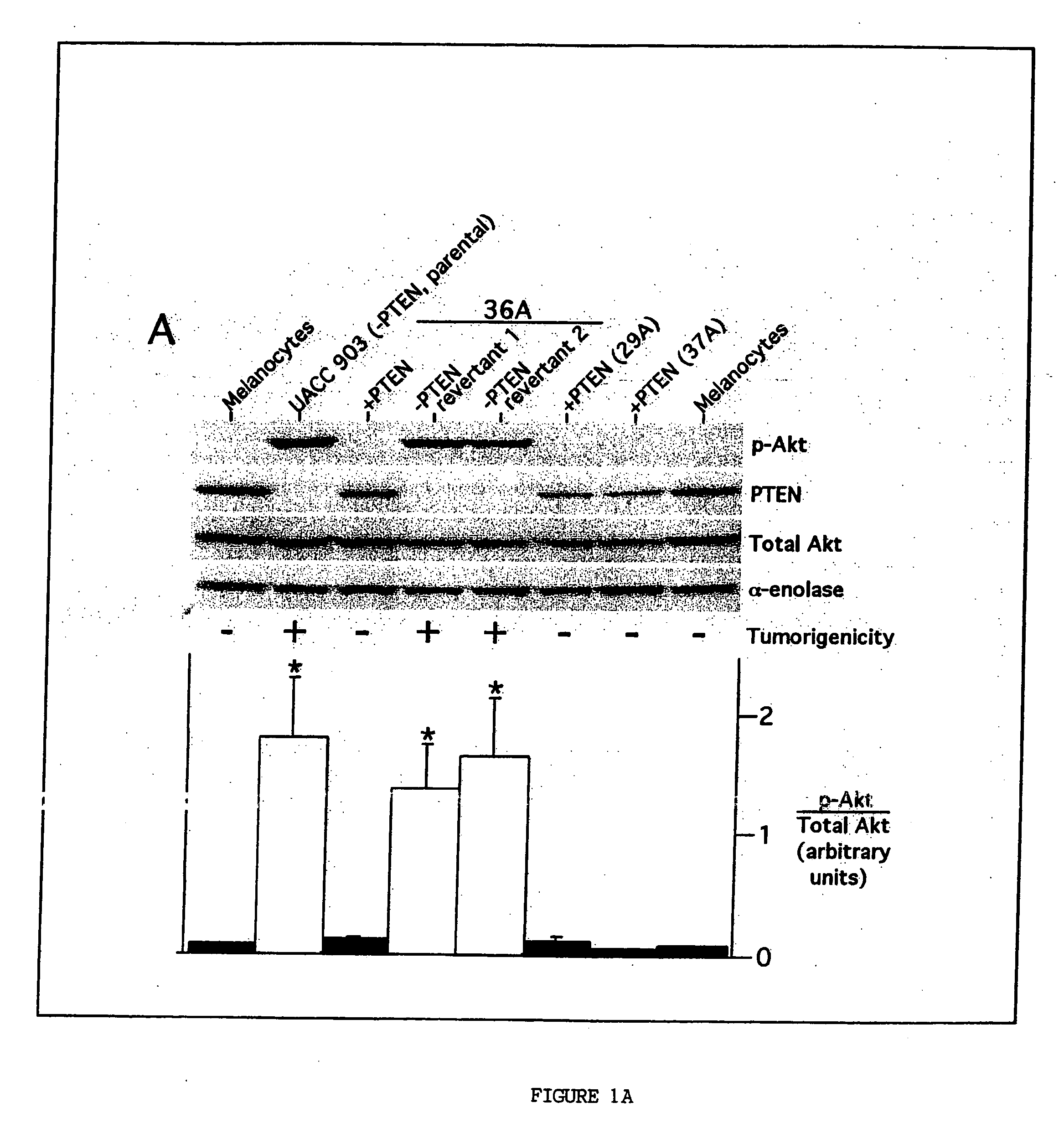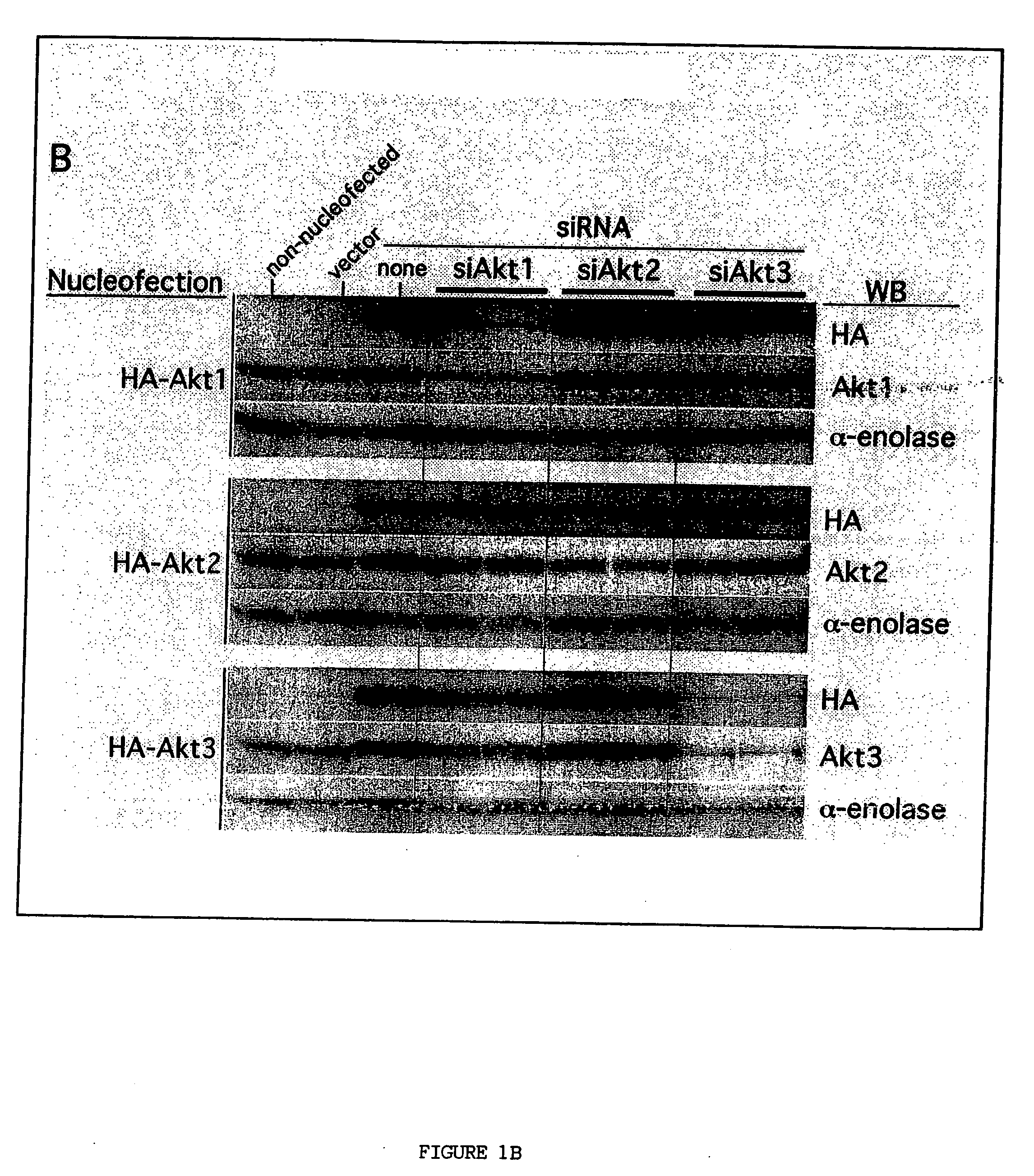Combinatorial methods and compositions for treatment of melanoma
a technology of melanoma and compositions, applied in the field of melanoma treatment, can solve the problems of poor treatment progress of patients in the late stages of the disease, lack of effective therapeutic regimes, and many normal cells of the body are also susceptible to toxic substances, so as to reduce akt3 activity, restore normal apoptotic sensitivity to cancer cells, and reduce akt3 activity
- Summary
- Abstract
- Description
- Claims
- Application Information
AI Technical Summary
Benefits of technology
Problems solved by technology
Method used
Image
Examples
example 1
SiRNA Mediated Downregulation of Akt isoforms
[0225] To demonstrate the specificity of siRNA against Akt1, Akt2 and Akt3 (Dharmacon) in UACC 903 cells, HA-tagged Akt1, Akt2 or Akt3 constructs were co-nucleofected together with each respective siRNA. The Akt constructs used for these studies have been described previously (Sun et al., Am J Path 159:431-437 (2001); Mitsuuchi et al., J Cellular Biochem 70:433-441 (1998); and Brodbeck et al., J Biol Chem 274:9133-9136 (1999)). Each construct (5 μg), either alone or in combination with 100 pmol or 200 pmol of each respective siRNA, was introduced into 7×105 UACC 903 cells via nucleofection using an Amaxa Nucleofector. The resultant transfection efficiency using constructs expressing GFP was >60%. Protein lysates were harvested 72 h later and Western blot analysis performed as described previously (Stahl et al., Cancer Res 63:2891-2897 (2003)). Nucleofection with siRNA was also used to knockdown endogenous expression of the Akt isoforms a...
example 2
Western Blotting, Immunoprecipitation and Kinase Assays
[0226] The Western blot procedure and antibodies used, except for Akt2 (Santa Cruz) and Akt3 (Upstate Biotech), have been reported previously (Stahl et al., Cancer Res 63:2891-2897 (2003)). For immunoprecipitation, protein was collected following addition of protein lysis buffer (50 mM Tris-HCl pH 7.5, 0.1% Triton X-100, 1 mM EDTA, 1 mM EGTA, 50 mM NaCl, 10 mM sodium β-glycerol phosphate, 5 mM sodium pyrophosphate, 1 mM sodium orthovanadate, 0.1% 2-mercaptoethanol, and 0.5% protease inhibitor cocktail (Sigma)) to plates of cells followed by snap freezing in liquid nitrogen. Cellular debris was pelleted by centrifugation (≧10,000×g) of lysates and protein concentration quantitated using the BioRad BCA Protein Assay. Protein for immunoprecipitation (100 μg) was incubated with 2 μg of Akt2 or 5 μl of Akt3 antibody overnight at 4° C. with constant mixing. Next 15 μl of equilibrated GammaBind G Sepharose beads (Amersham Biosciences)...
example 3
Tumor Studies and Apoptosis Measurements
[0228] Collection of melanoma tumors from human patients was performed according to protocols approved by the Penn State Human Subjects Protection Office, the Dana-Farber Cancer Institute Protocol Administration Office, and Cooperative Human Tissue Network. Formalin-fixed paraffin embedded archival melanoma specimens were used for immunohistochemistry to measure phosphorylated Akt. Sixty-three formalin-fixed paraffin embedded archival specimens of melanocytic lesions were used for immunohistochemistry experiments with the phosphor-Akt (Ser473) monoclonal antibody (Cell Signaling Technology) at a 1:50 titer according to the manufacturer's recommended protocol. Specificity and intensity of staining was determined through qualitative comparison to internal blood vessel endothelium, squamous epithelium or smooth muscle controls present in each specimen.
[0229] Tumor protein for Western blotting or immunoprecipitation was collected by using a mort...
PUM
| Property | Measurement | Unit |
|---|---|---|
| size | aaaaa | aaaaa |
| TM | aaaaa | aaaaa |
| temperature | aaaaa | aaaaa |
Abstract
Description
Claims
Application Information
 Login to View More
Login to View More - R&D
- Intellectual Property
- Life Sciences
- Materials
- Tech Scout
- Unparalleled Data Quality
- Higher Quality Content
- 60% Fewer Hallucinations
Browse by: Latest US Patents, China's latest patents, Technical Efficacy Thesaurus, Application Domain, Technology Topic, Popular Technical Reports.
© 2025 PatSnap. All rights reserved.Legal|Privacy policy|Modern Slavery Act Transparency Statement|Sitemap|About US| Contact US: help@patsnap.com



